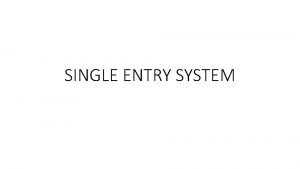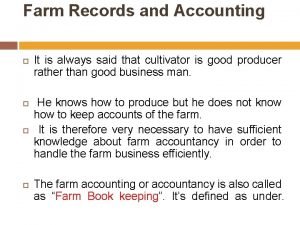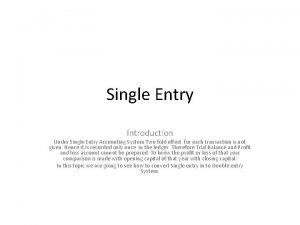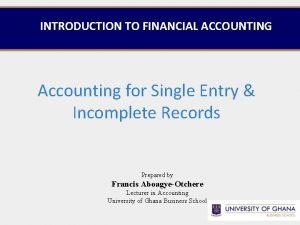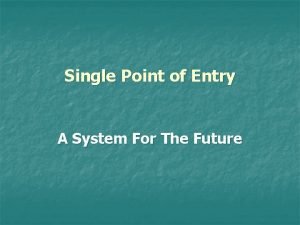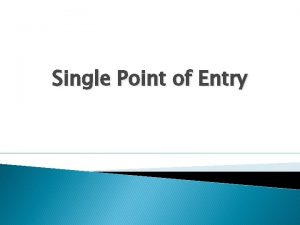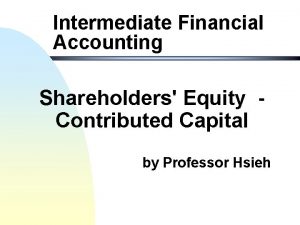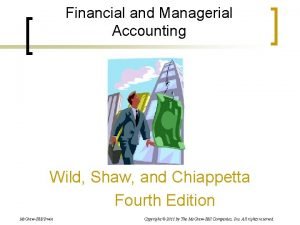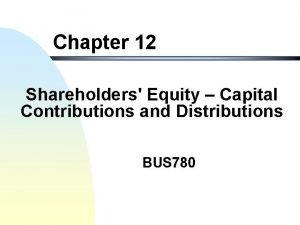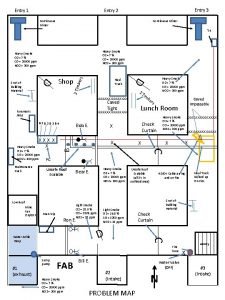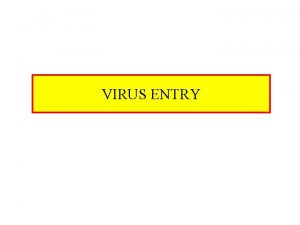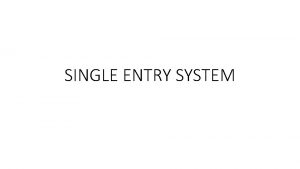INTRODUCTION TO FINANCIAL ACCOUNTING Accounting for Single Entry

















- Slides: 17

INTRODUCTION TO FINANCIAL ACCOUNTING Accounting for Single Entry & Incomplete Records Prepared by Francis Aboagye-Otchere Lecturer in Accounting University of Ghana Business School

Learning Objectives Explain how the accounting equation permits the measurement of profit when accounting records are incomplete. Draw up a statement of affairs of a business with single entry and incomplete records. Determine profit from incomplete records using opening and closing statement of affairs. Deduce sales and purchases figures from single entry and incomplete records. © F. Aboagye-Otchere, U. G. B. S. , (Accounting Dept. )

Importance of Keeping Records • • Performance assessment Planning and control of operations Tax purposes Determination of profit/loss Requirement for sourcing for funds Business Valuations Others- extraction of trial balance, identification of errors, misappropriation © F. Aboagye-Otchere, U. G. B. S. , (Accounting Dept. )

Cash Basis and Accrual Basis • Cash Basis of accounting – Used when revenue is recognized based on cash actually received and expenses is recognized only when payment is made. – This method is commonly used by small and petty traders who are unable to advance credit for goods sold. • Accrual Basis of accounting – Revenue is recognized (earned) once goods are delivered or services rendered to a customer and expenses are incurred once benefits is derived or services are provided by another party. – This method is widely used by most businesses and all corporations. © F. Aboagye-Otchere, U. G. B. S. , (Accounting Dept. )

Incomplete Records • Accounting records which have not been maintained according to strict double entry principles. • Full records are not kept either because – – – the proprietor of the business doesn’t keep a full set of accounts. some of the business accounts are accidentally destroyed or lost. there is no legal requirement. the cost of a bookkeeper is not justified. information for preparation of financial statements can be obtained from other sources. © F. Aboagye-Otchere, U. G. B. S. , (Accounting Dept. )

Determination of Profit • Net Assets (Capital) Approach – Based on the accounting equation. – The only way capital can increase is either by introduction of cash/resources or making profit. • Cash Book (Income) Approach – Elements of the financial statements are determined via series of adjusting entries. © F. Aboagye-Otchere, U. G. B. S. , (Accounting Dept. )

Net Assets (Capital) Approach • This method of determining profit/loss is based on the assumption that capital grows by way of profit and reduces by losses made. • Accounting equation: Assets – Liabilities = Capital Net Assets = Capital • Profits are determined using the opening and closing capital via the preparation of statement of affairs. © F. Aboagye-Otchere, U. G. B. S. , (Accounting Dept. )

Net Assets (Capital) Approach Statement of Affairs as at … Assets Non current assets xx Current assets xx xx Liabilities Non current liabilities xx Current liabilities xx Net Assets (capital) (xx) xx © F. Aboagye-Otchere, U. G. B. S. , (Accounting Dept. )

Profit Determination • Drawings – This has the tendency to reduce the closing capital and hence the profit. – They are either added to “apparent profit” or subtracted from “apparent losses” • Capital Introduced – This has the effect of increasing the closing capital and hence the profit. – It is therefore subtracted from the ‘‘apparent profit” or added to the “apparent losses” © F. Aboagye-Otchere, U. G. B. S. , (Accounting Dept. )

Net Assets (Capital) Approach Determination of Profit Closing Capital xxx Plus: Drawings xxx Less: Opening Capital (xxx) Additional Capital Profit /(Loss) (xxx) xx/(xx) © F. Aboagye-Otchere, U. G. B. S. , (Accounting Dept. )

Illustration Below are the opening and closing balances of Fear & Panic Enterprise, a trader at the night market for year 2006 and 2007: As at 31. 12. 2006 Van - $18, 000 Furniture - $5, 400 Trade Receivables - 12, 300 Inventories - $9, 000 Cash & Bank - $15, 000 Trade Payables - $3600 Loan from Kaya - $10, 500 As at 31. 12. 2007 Van (net of depreciation) - $15, 000 Furniture (net of depn. ) - $4, 800 Trade Receivables - $18, 600 Inventories - $11, 400 Cash & Bank - $23, 400 Trade Payables - $5400 Loan from Kaya - $6, 000 Drawings - $15, 600 © F. Aboagye-Otchere, U. G. B. S. , (Accounting Dept. )

Net Assets (Capital) Approach • Determine the opening and closing capital at the beginning and end of the period via preparation of statement of affairs. • Trace all withdrawals made by owners for their personal use (drawings). • Determine whethere have been any injection of additional capital • Based on the accounting equation, determine the profit or loss. © F. Aboagye-Otchere, U. G. B. S. , (Accounting Dept. )

Cash Book (Income) Approach • A full income statement and statement of financial position are prepared from the incomplete records provided. • It is mostly used when a cashbook could be drawn up, opening and closing balances are available and expenses incurred and revenue earned could be derived. © F. Aboagye-Otchere, U. G. B. S. , (Accounting Dept. )

Income Approach - Steps involved • Compute the opening capital (using the statement of affairs template) • Prepare your cash account to find missing figures such as drawings etc. • Ascertain credit sales (using Trade receivables control account) • Ascertain credit purchase (using trade payables control account) • Ascertain the expenses chargeable to the income statement by making adjustments to accruals and prepayments • Prepare income statement © F. Aboagye-Otchere, U. G. B. S. , (Accounting Dept. )

Incomplete Records and Missing Figures • Drawings/Cash Received/Cash Paid: – Where the missing amount is in respect of payments, then its normal to assume that the missing figure is the amount required to make both totals agree in the cash column of the cash book (note that for bank related transactions a copy of all transactions can always be obtained from the bank). • Where payments are less than receipts, it is likely that the missing figure is cash receipts from customers © F. Aboagye-Otchere, U. G. B. S. , (Accounting Dept. )

Illustration As a professional accountant, you have been hired by Mr. Sikadanka, owner of Hajia Shikishiki Enterprise, a sole proprietorship selling ‘fula’ at Zongo to help prepare his business’ final account for the year ending 31. 12. 2007. After a thorough check on his books you have obtained the following information about his business: a. No record of sales has been kept (most of which is usually on credit). A payment of $61, 500 ($48, 000 by cheque) has been received from a customer for credit sale earlier. b. A total of $31, 600 was paid to suppliers during the period by cheque. c. Expenses paid during the period (by cheque): rent $3, 800; general expenses $310; rent (by cash) $400 d. Mr. Sikadanka took $250 on a weekly basis as drawings. © F. Aboagye-Otchere, U. G. B. S. , (Accounting Dept. )

Illustration Additional information on Hajia Shikishiki enterprise are as follows: 31. 12. 2006 31. 12. 2007 $ $ Trade receivables 5, 500 6, 600 Trade payables 1, 600 2, 600 Rent owing 350 Bank 5, 650 17, 940 Cash 320 420 Inventories 6, 360 6, 800 Hajia Shikishiki enterprise’s only fixed asset was some fixtures valued at 31. 12. 2006 at $3, 300. This asset is depreciated annually at 10%. © F. Aboagye-Otchere, U. G. B. S. , (Accounting Dept. )
 Double entry method
Double entry method Difference between single and double entry system
Difference between single and double entry system Single entry system introduction
Single entry system introduction Trade payables control account
Trade payables control account The generation and exploitation of new entry opportunities
The generation and exploitation of new entry opportunities Financial accounting and accounting standards chapter 1
Financial accounting and accounting standards chapter 1 Responsibility accounting ppt
Responsibility accounting ppt Single point of entry meaning
Single point of entry meaning Single point of entry
Single point of entry Single entry and incomplete records
Single entry and incomplete records Sisd simd misd mimd examples
Sisd simd misd mimd examples Single instruction single data
Single instruction single data Single channel single phase example
Single channel single phase example 7 books of prime entry
7 books of prime entry Contributed capital formula
Contributed capital formula Stock split accounting entry
Stock split accounting entry What is the meaning of double entry system
What is the meaning of double entry system Statement of stockholders equity example
Statement of stockholders equity example
